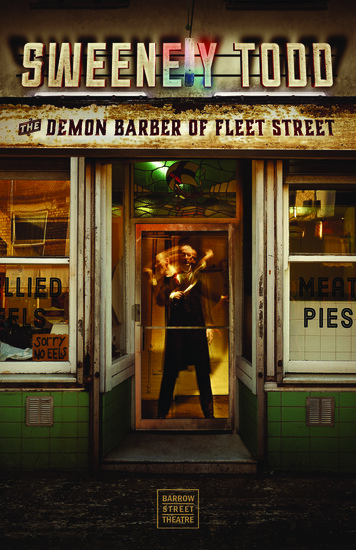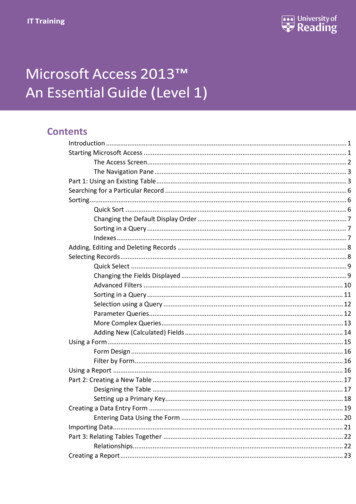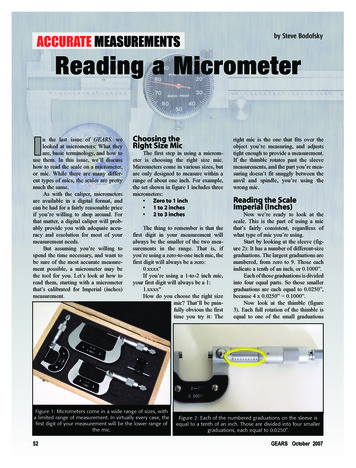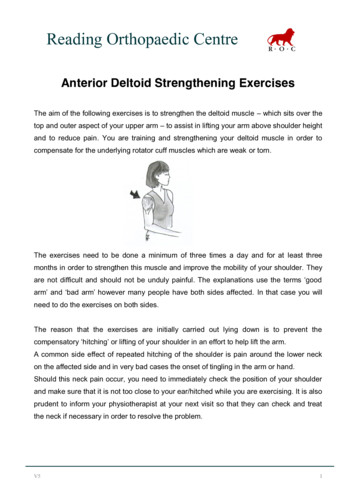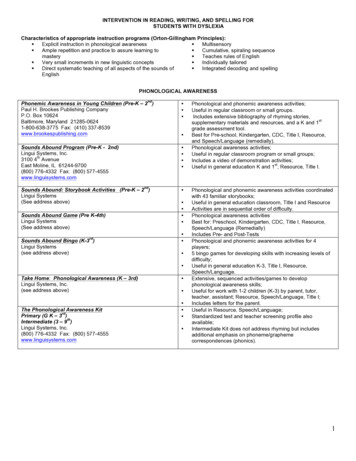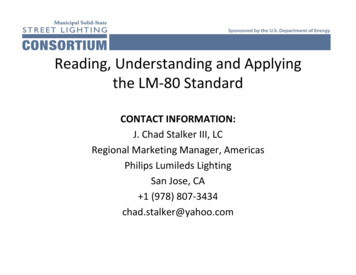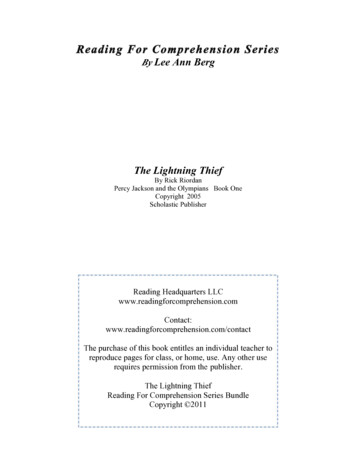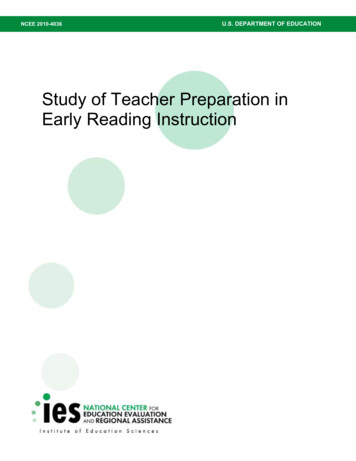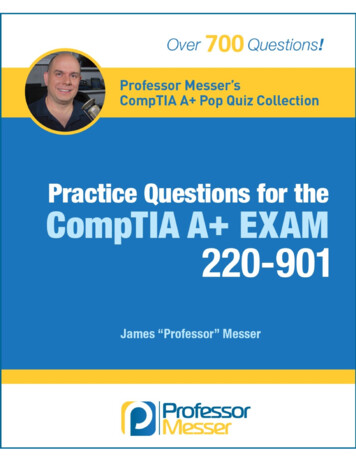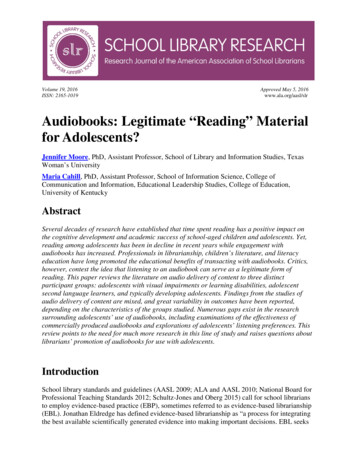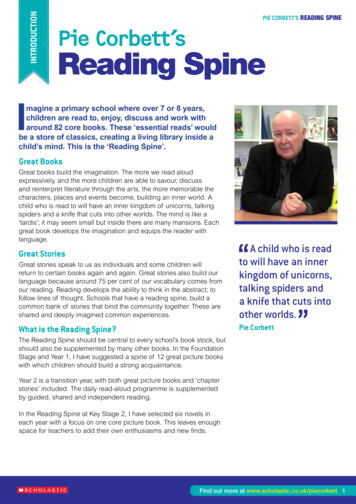
Transcription
INTRODUCTIONPIE CORBETT’S READING SPINEPie Corbett’sReading SpineImagine a primary school where over 7 or 8 years,children are read to, enjoy, discuss and work witharound 82 core books. These ‘essential reads’ wouldbe a store of classics, creating a living library inside achild’s mind. This is the ‘Reading Spine’.Great BooksGreat books build the imagination. The more we read aloudexpressively, and the more children are able to savour, discussand reinterpret literature through the arts, the more memorable thecharacters, places and events become, building an inner world. Achild who is read to will have an inner kingdom of unicorns, talkingspiders and a knife that cuts into other worlds. The mind is like a‘tardis’; it may seem small but inside there are many mansions. Eachgreat book develops the imagination and equips the reader withlanguage.Great stories speak to us as individuals and some children willreturn to certain books again and again. Great stories also build ourlanguage because around 75 per cent of our vocabulary comes fromour reading. Reading develops the ability to think in the abstract; tofollow lines of thought. Schools that have a reading spine, build acommon bank of stories that bind the community together. These areshared and deeply imagined common experiences.A child who is readto will have an innerkingdom of unicorns,talking spiders anda knife that cuts intoother worlds.What is the Reading Spine?Pie CorbettGreat StoriesThe Reading Spine should be central to every school’s book stock, butshould also be supplemented by many other books. In the FoundationStage and Year 1, I have suggested a spine of 12 great picture bookswith which children should build a strong acquaintance.Year 2 is a transition year, with both great picture books and ‘chapterstories’ included. The daily read-aloud programme is supplementedby guided, shared and independent reading.In the Reading Spine at Key Stage 2, I have selected six novels ineach year with a focus on one core picture book. This leaves enoughspace for teachers to add their own enthusiasms and new finds.Find out more at www.scholastic.co.uk/piecorbett 1
INTRODUCTIONPIE CORBETT’S READING SPINESteps to aReading SpineSTEP 1Establish the core of key books that all children will experience: theseshould be ‘must have’ reads – the classics. The finest books that youcan find! Leave space to add other books that come along or mightsuit the class. The aim is for every child to experience the pleasureand challenge of great literature.STEP 2Resource the core list: class sets are very useful so that the bookscan then be used for close study. As well as this, sets of six bookscan be used for guided reading. Also, try to gather other books/filmsby the same author for a wider author study.STEP 3On a daily basis develop your ability to read aloud for pleasure withexpression on a daily basis, bringing the story alive for children.STEP 4Help children to inhabit the world of the story through bookdiscussion, drama, art, dance, music, writing-in-role and play.Imaginative engagement with the text draws children into the tale,and makes it a deeper, more memorable and meaningful experience.STEP 5Learn how to draw on the core books to teach writing, for example,if you are teaching dialogue, use the core books as exemplars. Inthis way, both you and the children are constantly drawing on qualitymodels that they will begin to know well. Moreover, the books will helpto develop and deepen the children’s imaginative world, as well asbecoming a key resource for their writing.STEP 6You will also need to thread in poetry. The Works Key Stage 1 (whichincludes Reception) and The Works Key Stage 2 (both MacmillanChildren’s Books) provide banks of poems for enjoying, performingand discussing, and some may be used as models for writing. At theback of these two anthologies, the poems are organised by year groupto create a poetry spine. You may also wish to select core poets foreach term. Finally, it is important to thread into the Reading Spine highquality non-fiction. These books could be selected in relation to topicsbeing studied, but there may also be key books that a school wishes toensure children have encountered, such as The Diary of Anne Frank.Establish thecore of key booksthat all children willexperience: theseshould be ‘must have’reads – the classics.The finest books thatyou can find!Find out more at www.scholastic.co.uk/piecorbett 2
INTRODUCTIONPIE CORBETT’S READING SPINETop tips for usingpicture books (1)Of course, any teacher could come upwith an activity linked to a book. Thekey is to think about activities thatwill illuminate the meaning, help childrenengage at a deeper level and enterthe world of the story. Here is a wholealphabet of activities that should sparkyour children’s imagination:A Show the front/back cover. Ask: What sort ofstory is this? What might happen? Tell the story to apartner based on the cover image or start fromthe title.B Read through and pause every so often. Ask:What is going to happen next? Write, tell or draw thenext page, then discuss.C Invite the children to discuss what they enjoyedabout the book or what it reminded them of or meantto them.character or alter a key event.H Cover the dialogue with a sticky note beforeinviting the children to draw a speech bubble and towrite, then dramatise the conversation.IPause the reading and ‘freeze-frame’ thepage, then interview each character that appearson it. Ask: What are you thinking/feeling/hoping willhappen next? What are you regretting? Alternatively,use thought bubbles to explore the above.J Initiate a group performance using expression.K Use ‘what if’ statements to raise differentpossibilities in the narrative.L Re-enact the story by creating a whole-classphysical map, using children to represent parts of thestory. Then interview bystanders or even objects in roleas observers of the story – what did they see happen?D Explore links and connections. Ask: Can youfind where the story repeats itself? Are there linksbetween this story and our lives, or between thisstory and other stories?E As a class list possible questions, such asthings we are not sure about and would like todiscuss. List the questions and then choose the onesthat would be most fruitful to talk about.F Role-play a scene immediately after the bookhas finished or before the story starts. Alternatively,select an image from the middle of the book. Ask:What is happening? What might happen immediatelybefore and after?G Ask children to draw a map of the story andretell in their own words. Change the nature of aThe key is to think aboutactivities that will illuminate themeaning, help children engage at adeeper level and enter the world ofthe story.Find out more at www.scholastic.co.uk/piecorbett 3
INTRODUCTIONPIE CORBETT’S READING SPINETop tips for usingpicture books (2)M Use percussive instruments and ask childrento work in groups to set the story to simple rhythmsand musical patterns.N With the whole class create a dance toaccompany a story, such as the ‘rumpus’ in Wherethe Wild Things Are (HarperCollins).O Invite the children to illustrate or create a wallmap (using lining paper). Use print-making orpatterning to accompany a tale, picking up on anaspect in the story or images.V On the first reading use sticky notes to coverkey words in a story. Let the children discuss whatthey think the words might be, or what the effect onthe reader will be for their choice.W Rewrite a page but add extra description tocompensate for withdrawing a picture. With theclass compare the original page with the rewrittenpage.X Show the class just the pictures in the story.Can the children tell the story using only theimages?P Let the children choose how they will respondto a text – and add to your own repertoire ofpossibilities from their ideas.Y With the children make a 3D model ofsomething from a story, such as objects or settings.Q Use a shoebox to create a diorama of a keyscene.Z Provide costumes or hats for the children to usein a role play.R Fill a story bag with objects or puppets and amap linked to a story, so that children can take thebook home and explore the story through play.S Retell the story in small groups with somechildren playing a role and others providing thenarrator’s voice.T Display selected images and ask them if theycan work out what might happen on the pagesbefore and after. Alternatively, each group is givena picture and develops a telling of the story for thatpage as they see it. Then, the whole class performstheir section of the story in order to see how well thestory flows. Another option is to show three imagesfrom different parts of the story. Ask: In which ordershould the images be placed – and why?U In role as a character, encourage childrento step out of the tale and interact in a differentenvironment or scene. For example, join in with ‘teatime’ at the three bears’ cottage.Find out more at www.scholastic.co.uk/piecorbett 4
INTRODUCTIONPIE CORBETT’S READING SPINETop tips for usingnovels (1)Decide on where you will stopreading in order to carry out eachactivity or discussion. Here is awhole alphabet of activities that shouldspark your children’s imagination.A Ask the children to discuss theirpreferences and to explain their ideas.B Together explore links and connections.Ask: Are there links between this story, otherstories or works of art? How does the talemake a link with your own life?C Ask the children to list possible questions,such as things that they are not sure aboutand would be useful to discuss. List thequestions and then choose the ones thatwould be most fruitful to talk about.H In role as journalists, invite the children tointerview a character and write a news item –or broadcast it, with an ‘outside broadcastingunit’ carrying out the interview.IWith the class create and film a cartoon orfilmed version of the scene.J Build a story museum with the children torepresent scenes from the novel by gatheringand displaying objects, sounds (use talkingtins) and images from the story.K Provide or create with the children newsbulletins for key moments in the story.L Together draw ‘feelings graphs’ showingthe ups and down for the different charactersin the story.D In pairs, encourage gossip about theevents so far.E In stories where the characters haveproblems to solve, invite children to workin pairs with one in role as an agony auntand the other in role as a character who willexplain the problem. Encourage the ‘agonyaunt’ to provide some advice.F In pairs, sit the children back to backwith one child in role as a character phoninga friend. Encourage the character to explainwhat has been going on while the friendlistens and then responds with advice.G Working in-role as a character, invite thechildren to write a diary entry or letter to afriend about the main event/what has justhappened. Alternatively, they could write to acharacter offering advice.Here is a whole alphabet ofactivities that should spark yourchildren’s imagination.Find out more at www.scholastic.co.uk/piecorbett 5
INTRODUCTIONPIE CORBETT’S READING SPINETop tips for usingnovels (2)M Encourage children to choose theirfavourite word, phrase, line or section andshare. Ask: Why do you like that part?N Display images and ask: Which is the oneimage that says the most in the story? Whatdoes it say to the reader?O With the class select words thatencapsulate the essence of the book. Makea list of these key words and then select the‘best’/‘truest’ five words.P Let them choose a favourite line, phrase orword from the novel. Invite them to stand in acircle, take it in turns to step into the circle andsay the word aloud with a gesture. Encourageeveryone else to then repeat the word andgesture.Q Stand the group in a circle and ask eachU Invite children to role-play any event in astory that takes place in a different setting, butis referred to or suggested by the book.V During a reading session with the classalter a story by stopping, considering possibleplot lines and then retelling the story orrewriting it.W As a whole class put especially badcharacters on trial.X Ask children to create the back page blurbfor the story and design a new cover or advert.Y Invite groups to create a ‘for sale’ advertfor a character or the book itself.Z Provide time for children to write an end-of-term report for a character.of them to choose an action from an event inthe story that is memorable, then step into thecircle and mime the action. Then everyone elsecan imitate the action.R In pairs, encourage them to retell the storyword-by-word or sentence-by-sentence, orretell the story in cartoon form.S As a whole class select all the verbs froman action passage and list them in the orderthat they appear. Can they say them aloud withexpression? Ask: What is the effect? Now trythe same thing with the adjectives or nouns.T Provide time for individuals to create itemsfrom a book, including letters, diary entries,news items, postcards – any written item thatappears in a story or might appear.Find out more at www.scholastic.co.uk/piecorbett 6
INTRODUCTIONPIE CORBETT’S READING SPINEReading andsharing the books (1)Read from the class novel orpicture book on a daily basis. It isworth taking the time to read thebooks through beforehand and thinkingabout where you might wish to stopfor discussion or some sort of activity.Anyone can dream up 50 things to do witha book, but the key is to halt at momentswhere an activity or discussion is neededto deepen engagement and understanding.On most occasions, picture books should be readstraight through without endlessly stopping – thechildren want to hear the story! Only occasionallymight there be a moment to pause where a situationhas been set up and it is worth asking the childrento think about the possibilities for what mighthappen next. However, a good picture book willdemand re-reading over a number of days so thatyou can focus on different aspects of the story.‘Talk for
discussion, drama, art, dance, music, writing-in-role and play. Imaginative engagement with the text draws children into the tale, and makes it a deeper, more memorable and meaningful experience. STEP 5 Learn how to draw on the core books to teach writing, for example, if you are teaching dialogue, use the core books as exemplars. In this way, both you and the children are constantly drawing .
